May 23, 2008
Air Date: May 23, 2008
FULL SHOW
SEGMENTS
Farm Bill Food Fight
View the page for this story
President Bush's veto of the massive farm bill was plowed under by Congressional members eager to bring home some election year bacon. Host Bruce Gellerman talks with Daniel Imhoff, author of “Food Fight: The Citizen's Guide to a Food and Farm Bill,” for the big picture on the 2008 farm bill. (05:30)
On the Farm with the Farm Bill
/ Jeff YoungView the page for this story
The farm bill gives mixed messages to farmers when it comes to the environment – boosting conservation programs at the same time it subsidizes harmful farming practices. Living on Earth’s Jeff Young spent some time down on the farm to get a feel for what's working and what’s not with the bill, on the ground. (06:30)
China’s Plans for Dams on Shaky Ground
View the page for this story
Political scientist Andrew Mertha thinks dams damaged in the Wenchuan earthquake might shake up China's plans to triple its hydro-electric production by 2020. Host Bruce Gellerman talks with Mertha, author of the recent book “China’s Water Warriors,” about China's hydropower ambitions and the growing grassroots opposition to large-scale dam projects in the country. (06:00)
Damming the Developing World
View the page for this story
While interest in building hydro-electric dams is waning in the United States, developing nations are increasingly turning to their rivers to power their growing economies. Hydropower is finding financial help from China and carbon offset traders, but critics question the environmental and societal advantages of large-scale dams. Host Bruce Gellerman talks with International Rivers Director Patrick McCully about dams in the developing world. (04:40)
Out of the Box, Housing
/ Ingrid LobetView the page for this story
The increasing push to reuse materials has given one entrepreneur overnight success he says was 20 years in the making. Living on Earth’s Ingrid Lobet reports on a company that turns steel cargo shipping containers into housing. (04:00)
Small is Beautiful
/ Bonnie AuslanderView the page for this story
Commentator Bonnie Auslander is trying to raise her daughter to be a responsible steward of the environment. But she’s having a hard time convincing the pre-teener to value the small things in life. (03:10)
Green Grilling
/ Bobby BascombView the page for this story
As warm weather comes around, so does heated debate about whether to use charcoal or propane in the grill. Each method has its pros and cons. Living on Earth’s Bobby Bascomb reports on what the eco-conscious BBQer should fire up this summer. (05:00)
Searching for Life on the Red Planet
View the page for this story
NASA’s latest mission to Mars is set to land on the red planet this week in search of evidence that the planet can support life. Tufts University extreme chemist, Dr. Sam Kounaves, built the “laboratory in a teacup” that will test the frozen martian soil. Living on Earth host Bruce Gellerman stopped by the Tuft’s lab for a close encounter. (09:00)
Mars Music
/ Marty QuinnView the page for this story
The data collected from the 2001 Mars Odyssey Mission actually makes for beautiful music, according to Marty Quinn. The computer scientist and drummer used a computer program to turn mission data into music. (02:45)
This week's EarthEar selection
listen /
download
Greater Prairie Chickens on a lek in Nebraska National Forest.
Show Credits and Funders
Show Transcript
HOST: Bruce Gellerman
GUESTS: Daniel Imhoff, Sam Kounaves, Patrick McCully, Andrew Mertha
REPORTERS: Bobby Bascomb, Bruce Gellerman, Ingrid Lobet, Jeff Young
COMMENTATOR: Bonnie Auslander
[THEME]
GELLERMAN: From Public Radio International – it’s Living on Earth.
[THEME]
GELLERMAN: I’m Bruce Gellerman. The feds give farmers a helping hand – and then some. The new farm bill provides 43 billion dollars in subsidies at a time when crops are producing bumper profits. The President vetoes it, calling it “bloated.”
HOPPER: We could have had a bill that the president would have signed that would have contained significant reform of farm subsidies, and we could have seen a bigger increase in conservation funding. In general it’s just a failure of leadership I think all around.
GELLERMAN: The farm bill – what’s in it for you? Also, are we alone? We soon may have answers – searching for life on Mars.
KOUNAVES: We’re looking for microbial life. We don’t expect to find little things scurrying around Mars or anywhere in the solar system. What we’re hoping to find, like in the dry valleys, is simple, microbial life that has evolved and survived for billions of years.
GELLERMAN: Life on Mars – this week on Living on Earth. Stick around!
ANNOUNCER: Support for Living on Earth comes from the National Science Foundation and Stonyfield Farm.
[RETURN THEME]
Farm Bill Food Fight
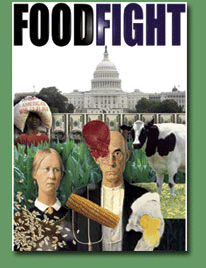
Daniel Imhoff’s new book is "Food Fight The Citizens Guide to a Food and Farm Bill." (Courtesy of Watershed Media)
GELLERMAN: From the Jennifer and Ted Stanley Studios in Somerville, Massachusetts – this is Living on Earth. I’m Bruce Gellerman, in for Steve Curwood. Money might not grow on trees, but you’ll find plenty in fields. The new 307 billion dollar federal farm bill includes 43 billion dollars in crop subsidies – this at a time when farmers are receiving record prices for what they grow. That’s one reason President Bush vetoed the bill, but it’s veto-proof; it has overwhelming support in Congress.
But the president isn’t the only critic, and Daniel Imhoff details many of their complaints in his book “Food Fight: A Citizen’s Guide to a Food and Farm Bill.” Daniel Imhoff joins me from a studio at KWMU in St Louis. Dan, welcome!
IMHOFF: Thanks for having me.
GELLERMAN: This is a monster of a bill.
IMHOFF: Yea. It’s more like a black hole. It’s dealing with everything from nutrition to what we grow and how we manage it, to conservation, even racehorse breeding in Kentucky.
GELLERMAN: Well you found plenty to criticize in the bill in your book, and you joined The New York Times, which criticizes it; George Bush when he vetoed it, called it a “bloated bill”; the Secretary of Agriculture says it’s reckless spending; overseas writers have said it’s outrageous. What’s wrong with the Farm Bill?
IMHOFF: I think what’s obviously wrong to most people is that it’s been really hi-jacked by huge agribusinesses. We’re focusing on a very narrow range of crops – corn, cotton, wheat, rice, soybeans, sugar, milk – much of these commodities are produced in these huge, huge industrial operations, and much of these commodities also aren’t really directly eaten by people, but rather they’re fed to cattle, they’re made into ethanol, they’re made into all kinds of food-processing additives or refined flours and sugars and oils that are actually contributing to a nutritional crisis.
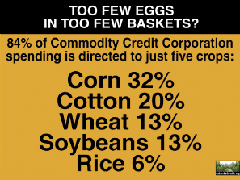
(Courtesy of Watershed Media)
IMHOFF: They do. And I really think it’s time for us to ask the question whether or not we can really develop sound farm policy while we debate nutrition policy at the same time.
GELLERMAN: So, you think we should have two bills – a farm bill and a food bill?
IMHOFF: I think if we had two bills, there would be a lot less of the horse-trading that goes on and perhaps a lot more time for reflection to see, you know, where are the public benefits in these programs? What are the goals that we have for agriculture moving forward?
GELLERMAN: Well, you mentioned horse-trading. Some of the subsidies do go to racehorses in Kentucky. There’re also, what, some money in there to prevent puppies from being imported from overseas.

Daniel Imhoff’s new book is "Food Fight The Citizens Guide to a Food and Farm Bill." (Courtesy of Watershed Media)
IMHOFF: You know, I have not heard about the puppies (laughs), but, you know, nothing surprises me. In order to get this bill, you know, just a huge number of earmarks, pork projects, are brought home, and you have to really ask the question, is it responsible to pass a bill about agriculture which deals with racehorses?
GELLERMAN: Hmm. Well this bill was touted by many as being reform. Are we getting our money’s worth, you think?
IMHOFF: No, no. I think we have a Congress asleep at the wheel. If we really had a much broader vision for our food and agriculture system, we could really use the 307 billion dollars to create something much better than we have right now. And, you know, I think, if you look back, you can’t underestimate the amount of money that, of the agribusiness lobby that influences and writes policy.
GELLERMAN: So, what does the veto mean now, though?
IMHOFF: I just think it’s posturing and it’s really just a statement to appease certain constituents who want President Bush to take a really hard line on spending. The administration has a lot of chances to come to the table, and if they were very serious about the changes that they were trying to recommend with eligibility requirements, spending caps, true reductions in the commodity title, we would have had them.
GELLERMAN: I wonder – it’s 673 pages long. You think anybody reads the whole thing?
IMHOFF: It’s not only that long; it’s constantly in flux. The important thing to remember about this bill is that this is just stage one – this is when the promises are made. And then every year for the next four to five years, as it’s time to appropriate, to either fund or not fund programs that have been promised, then further decisions are made and further legislation takes place. So even though you might be promised a certain amount of money for, you know, farmers’ markets expansion or organic research, there’s almost no guarantee that you’re gonna get it in the long run, unless the appropriators honor those promises and don’t give them for something else. And history shows that normally those, those projects, those programs with the most public benefit – conservation, value-added processing, rural development – get cut, while the commodities supports stay in place or are even increased.
GELLERMAN: Well, Mr. Imhoff, thank you so very much.
IMHOFF: I really appreciate your time.
Related link:
To learn more about the book “Food Fight,” click here
On the Farm with the Farm Bill
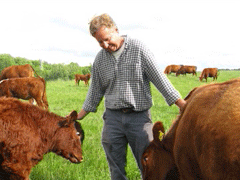
Farmer Michael Heller says Farm Bill money will encourage healthy pasture practices to keep nutrient runoff out of the Chesapeake Bay. (Jeff Young)
GELLERMAN: Daniel Imhoff’s book is called “Food Fight: A Citizen’s Guide to a Food and Farm Bill.” Critics may find plenty of pork in the legislation, but many members of Congress are only too happy to bring home the bacon to their constituents. Among them environmentalists, who are pleased with some of the provisions aimed at protecting the land. Living on Earth’s Jeff Young went down on the farm for a closer look and put his ear to the ground.
[TRACTOR ENGINE]
YOUNG: Clagett Farm in Maryland lies just outside of Washington, D.C. It’s a good example of how action inside the beltway can change how farmers do business in the real world outside the beltway.
[TRACTOR ENGINE FADES; TRAILER HITCH CLANKS]
YOUNG: Farm manager Michael Heller is putting away a load of rye straw. More area farmers might do the same, thanks to the extra money in the Farm Bill’s conservation programs.
HELLER: The rye’s really great ’cause it not only protects the soil over the winter months, but it sucks up any left-over nitrogen, and binds it up in the plant. And then in the spring we’ll harvest it and use it to mulch our vegetables, so it’ll rebuild the soil and protect the soil from erosion. So it works really well for our farming system, but it also works for the bay.
YOUNG: That’s the Chesapeake Bay he’s talking about. Its once rich stocks of fish, crabs and oysters are imperiled by the suffocating effects of excessive nutrients.
[TRICKLING STREAM]
YOUNG: Heller runs the farm for the Chesapeake Bay Foundation as a working, profitable business that demonstrates best practices to keep nitrogen and phosphorous out of the rivers and streams that feed the bay.
[TRICKLING STREAM]
HELLER: When you add up all the little streams, I mean this stream is barely two feet across, but it runs pretty robustly and you get a good rainstorm, and with the thousands of little streams like this it has a tremendous impact.

Farmer Michael Heller says Farm Bill money will encourage healthy pasture practices to keep nutrient runoff out of the Chesapeake Bay. (Jeff Young)
HELLER: In the bay region, about 40 percent of the nitrogen and about the same amount of the phosphorous entering the bay is coming from agriculture.
YOUNG: So with these conservation programs, you‘ve got an opportunity to take a bite out of almost half of the nutrient problems.
HELLER: The beauty of agriculture is it’s the cheapest place to reduce your nutrients. Wastewater treatment plants are much more expensive than paying farmers to control the nutrients on their land, and generally it benefits the farms as well.
[WALKING THROUGH TALL GRASS]
YOUNG: Clagett Farm has buffer zones of grass and trees along streamside to catch and filter out nutrient runoff. Heller also fences off the streams to keep cattle and their manure out of the water.
[COWS MOO]
HELLER: Hey, guys!
[COWS MOO]
HELLER: Now as you walk through here you’ll see lots of clover coming up in the grass. The clover fixes nitrogen so we don’t have to spread nitrogen fertilizer on the hay here. That’s the sort of thing that the conservation programs in the farm bill will help farmers manage pastures really well, because really good pasture is good for the bay.
YOUNG: Why wouldn’t a farmer just do this on his own?
HELLER: Most of these practices really cost something and the problem with many of them is, while there are long-term benefits, there are short-term, fairly substantial costs. I think farmers are interested in doing things as well as they possibly can if the funding support is there to help them, you know, do it.
YOUNG: About half a million farmers, foresters and ranchers around the country applied for conservation programs since 2002, but were turned away because there wasn’t enough money. The new bill adds about four billion to those programs. Chesapeake Bay Foundation President Will Baker says about 80 million a year will go to the six states in the Chesapeake Bay watershed.
BAKER: We think this may be the most important vote ever to come out of Congress for the Chesapeake Bay in history. We think there’s a possibility that we may be at a tipping point. We think it has the potential to dramatically change water quality in the bay over the next five years.
YOUNG: Great Lakes and Everglades restoration programs will also benefit. There’s even some money to protect pollinator habitat at a time when declining honeybee populations can sure use some help. But that’s not the whole picture. Some other conservation programs got the axe, like one called Sod Savers. It would have discouraged farmers from plowing up native prairie grasses. But farm state senators gutted that provision.
And critics say the bill’s subsidies to commodity crops like cotton, rice and corn still promote environmentally harmful practices that can cancel out the benefit of the conservation programs. Sarah Hopper is an attorney with Environmental Defense Fund.
HOPPER: Basically it’s like having a foot on the brake and a foot on the gas at the same time. We’ve got provisions in the commodity title that encourage certain behaviors, and then in the conservation title we pay farmers to do the opposite thing.
YOUNG: Hopper used to work for the Senate Agriculture Committee, where she learned a few things about how the Farm Bill works. She says the bill makes it much easier for farmers to get crop insurance and disaster payments, and that makes it more likely that marginal lands will be put into production, often in sensitive areas more prone to drought.
HOPPER: With prices very high and then the assurance that Uncle Sam is gonna be there to bail you out, it changes the math and I think you’re gonna see people breaking out that new land. So you're damaging the environment and you’re going to increase the taxpayer burden in terms of bailing those folks out when you have a loss.
YOUNG: So, on balance, who’s right here? The president who wants to veto this bill or the Congress, which will almost certainly override his veto?
HOPPER: You know, that’s a hard question to answer, Jeff. I mean, the overall point I think that people need to understand is that it’s a very disappointing state of affairs that we’ve ended up here. We could have had a bill that the president would have signed, and we could have seen a bigger increase in conservation funding. In general I think it’s just a failure of leadership all around.
YOUNG: Hopper calls it a mixed bag at best. Conservation programs will grow, but, for the most part, the Farm Bill means business as usual down on the farm.
For Living on Earth, I’m Jeff Young in Prince George’s County, Maryland.
Related links:
- The Government Accountability Office report on loss of native grasslands
- An overview of the Farm Bill from the Senate Agriculture Committee
- Environmental Defense Fund on the Farm bill
- The Chesapeake Bay Foundation
[MUSIC: Robert Plant/Allison Krause “Through The Morning, Through The Night” from ‘Raising Sand’ (Rounder Records – 2007)]
GELLERMAN: Coming up – there are lies, damn lies and statistics. We talk about dam statistics. Go with the flow – on Living on Earth.
China’s Plans for Dams on Shaky Ground
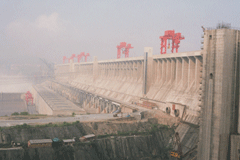
GELLERMAN: It’s Living on Earth – I’m Bruce Gellerman. The earthquake that struck central China killed tens of thousands of people, left millions homeless, and caused billions in destruction. Among the structures damaged are nearly 400 dams in Sichuan province. Soldiers have been patching cracks in the dam walls and engineers releasing reservoirs of water to prevent catastrophic collapse. Half the world’s large dams are in China, and the country’s banking on hydropower to fuel its energy future: there are plans to triple generating capacity in the next 12 years.
But in light of the earthquake, one expert says China’s likely to rethink those plans as opposition to hydropower dams grows. Andrew Mertha is an assistant professor of political science at Washington University in St. Louis, and author of the book, “China’s Water Warriors: Citizen Action and Policy Change.”
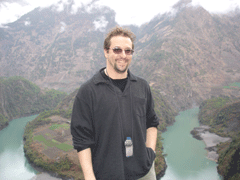
Andrew Mertha at the first bend of the Nu River in southwestern China, where a large-scale dam project was suspended in 2004 amid controversy. (Courtesy of Andrew Mertha)
GELLERMAN: Why would a political scientist be interested in Chinese dams?
MERTHA: Because dams are an insight into how the political system operates, both in terms of territories, local governments, as well as various functional bureaucracies – they tend to fight over the construction of these dams. So in order to get anything built, politics are at the center of it. And China, as you know, has been able to get by so far with its impressive coal reserves. But because of pollution hindering economic development, and because of competition with the United States and other countries, they really need to focus on renewable sources of energy that can be produced within China itself.
GELLERMAN: Sichuan Province, where there was this terrible earthquake, seems to be the focal point of a lot of the hydropower in China, am I right?

The Three Gorges Dam on the Yangtze River is 350 miles east of the epicenter of the Wenchuan earthquake. It will be the largest hydropower dam in the world when construction is finished. (Courtesy of Andrew Mertha)
GELLERMAN: Mao Zedong figures in one of the three case studies in your book. He wants to swim in an area, and he’s told he can’t. That leads the leadership of China to want to build a dam there.
MERTHA: Yea. Mao was an avid swimmer – and maybe swimming is not the right word. He liked to float on his back a lot. And he would take swims at significant times to underscore a political message. In this case, it seems that he just wanted to go for a dip in the Min River when he was visiting Sichuan in the late ‘50’s, and because the river itself was somewhat difficult to navigate, he was told finally that he was unable to do so.
GELLERMAN: And then the bureaucrats turn around and say, well we gotta let the Chairman swim the river, so let’s build a dam!
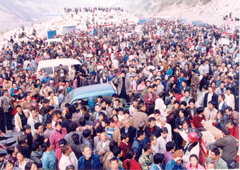
Around 100,000 people turned out in 2004 to protest construction of the Pubugou Dam in Sichuan Province. The Chinese government delayed construction for a year and now expects to finish the 3,330 MW dam by 2010. (Courtesy of Andrew Mertha)
GELLERMAN: So that was the key? That it was a grassroots opposition in China?
MERTHA: It’s difficult to believe. But in China there are anywhere up to two million non-governmental organizations.
GELLERMAN: We in the West tend to look at China politically as a monolith.
MERTHA: Well, it’s anything but. When the opposition is successful, they’re successful because they’re able to frame the issue in a certain way. In the case of Dujiangyan in Sichuan, along the Min River, they’re successful because Dujiangyan is also the home of a more than 2000 year-old irrigation project that is still functioning, still in place, and is something that resonates with Chinese historical identity. So they were able to change the focus of debate from economic development to the preservation of cultural heritage.
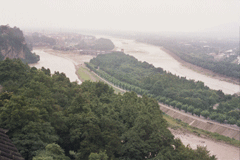
The 2,300-year-old Dujiangyan Irrigation System is praised for controlling floods and supporting agriculture while not obstructing the Min River’s natural flow. (Courtesy of Andrew Mertha)
MERTHA: Well, the fear is always there because hydropower stations are best built in areas that are also earthquake-prone. And of course the water filling up the reservoir provides weight on the earth that contributes to instability. But these are things that were discussed for sure, but they were not really useful to the opposition as ammunition in the discourse over whether or not to build these stations.
GELLERMAN: Hydropower is really going to be one of the primary sources of energy for China of the future. What happens if the protest movement against these dams is successful and they don’t have the energy to fuel their future?
MERTHA: Well, in the short to medium term, what that would mean is increased reliance on traditional sources of energy: coal, for example, non-renewable fossil fuels, for example, and in the latter case that would mean competition with the United States, with the EU, with Japan, and the increase of oil prices even more.
GELLERMAN: Well, Professor Mertha, thank you very much.
MERTHA: It’s been my pleasure.
GELLERMAN: Political scientist Andrew Mertha’s book is “China’s Water Warriors: Citizen Action and Policy Change.”
Related link:
To learn more about Andrew Mertha’s work, click here
Damming the Developing World
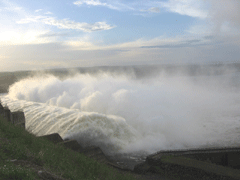
Tucurui dam in Brazil. (Courtesy of International Rivers)
GELLERMAN: Well the World Bank used to finance many big dam projects, but citizen action and environmental concerns have changed that policy. Yet many developing nations still see hydropower as an untapped renewable source of clean energy. International Rivers monitors dam building around the world. Patrick McCully is executive director of the conservation group, and he says there’s no shortage of cash to fund big dam projects.
MCCULLY: What’s happened is that countries like Brazil, India, China, now they have a lot more of their own resources so they don’t need international money so much, and one other really major factor in dam building around the world at the moment is that China actually is going around the world and writing checks for big dams without any types of environmental or social policies, and in many ways replacing the role that the World Bank and other Western funders used to play.

Brazil first proposed damming the Xingu River in the Amazon Basin in the 1970s. After canceling previous plans, it now plans to build the Belo Monte Dam, what could be the world’s third largest dam when built.
Credit: (Courtesy of International Rivers)
MCCULLY: Partly it’s promoting their own industries. So when China is funding, for example, a big dam in Sudan that they’ve been building which is very controversial, and their Chinese construction companies get all the contracts, so that’s an obvious reason for the Chinese to want to promote it. But there’s also geopolitical reasons. So, again, use Sudan as the example, China is very keen to have good relations with Sudan because they want to get Sudanese oil, so building a dam is a good way of cementing relationships.
GELLERMAN: It’s ironic that worldwide there’s this resurgence of dam building, and yet here in the United States, there are a lot of river restoration projects and the removal of dams, going back to, well, about 1999.

Tucurui dam in Brazil. (Courtesy of International Rivers)
GELLERMAN: Yeah, I understand that would be the largest dam in the world – much bigger than the Three Gorges Dam in China.
MCCULLY: Yea, by far, more than twice as big as Three Gorges Dam, and with a price tag several times as big, being built in one of the most unstable and conflict-ridden and corrupt countries in the world. The record of these big projects is that they spark off lots of corruption and can lead to conflict of various types.
GELLERMAN: What role, if any, do carbon offsets play in the construction of dams – that is, if they build a dam, they get credit towards polluting carbon dioxide in other places?

Patrick McCully, executive director of International Rivers, says large hydropower dams can emit as much greenhouse gases as coal plants.
(Courtesy of International Rivers)
GELLERMAN: But Mr. McCully, what’s wrong with a dam? I mean, they don’t emit greenhouse gases, they do produce electric power – what’s wrong with that?
MCCULLY: Well, biggest problem usually is these big dam projects is that they displace huge numbers of people and cause great harm to their livelihoods. When you build these great mega-projects, their power lines go off to the cities and the mines and the industries, and they don’t provide benefits to local communities, and they do great harm to riverine ecosystems. But beyond that, the argument that they are by their nature climate friendly is very simplistic. In fact the big reservoirs in the tropics can have very large greenhouse gas emissions, because basically flooded vegetation and soils, and that produces methane, and that’s a very powerful greenhouse gas. So the big Amazonian reservoirs, for example, can have much higher global warming impact than fossil fuels, even than coal plants.
GELLERMAN: I’m wondering, personally, you know, you’re up against some of the biggest corporations and countries in the world. Do you ever feel like that little Dutch boy with the finger in the dike, you know, trying to hold this thing back?
MCCULLY: (chuckles) Yeah, sometimes it’s – sometimes it’s easy to feel a bit overwhelmed, but at the same time we have a great global network of organizations that we work with. There’s also in the rise of renewable energy, falling price of solar, the increasing feasibility of wind power in many places. So the clean energy alternatives are much more viable that they used to be, which is a great thing for us.
GELLERMAN: Well, Mr. McCully, thanks very much. I appreciate it.
MCCULLY: It’s a pleasure.
GELLERMAN: Patrick McCully is executive director of the conservation group International Rivers.
Related link:
To learn more about International Rivers, click here
[MUSIC: DJ Logic/Jason Miles “Spice Island” from ‘Global Noize’ (Shanachie – 2008)]
Out of the Box, Housing

The right side of this home is an addition made of shipping containers.(Courtesy of SG Blocks)
GELLERMAN: Shipping containers are those big steel boxes you find at ports, rail yards, and loaded on trucks. And usually they’re used for just that – shipping. But as Living on Earth’s Ingrid Lobet reports, some entrepreneurs are transforming containers into home sweet home.
[FORKLIFT BEEPS]
LOBET: Forklifts move exhibits into place at the EcoBuild America show in Orange County, CA. David Cross of SG Blocks stands at his exhibit, a steel box with one half converted into a living space.
CROSS: What we're looking at here is a forty-foot cargo container: eight feet wide, it’s nine and a half feet tall and it’s forty feet long.
[BANGING ON SIDE OF METAL CONTAINER]
LOBET: One side of the container has been removed, and window and door openings have been cut into the sides and ends.
CROSS: As you see it, a tremendous amount of material has been removed from it. It's been augmented, so now it’s a structural steel building system that formerly was a cargo container.
LOBET: Cross says buildings made this way can withstand 175 mile per hour winds. And the containers or ‘blocks’ can be stacked, cut, and integrated by an architect into various styles. In fact in several buildings SG Blocks has helped build, it's hard to discern the containers within
CROSS: We're the bones of it, but what the exterior and the interior looks like is up to the architect and their clients.

The right side of this home is an addition made of shipping containers.(Courtesy of SG Blocks)
LOBET: That's Bill Hinchliff of ConGlobal Industries. His company partners with SG Blocks.
Typically how a projects works is a homeowner or developer hears about the shipping containers, and then puts SG Blocks in contact with their architect for the design. ConGlobal does the welding and custom cutting. The contractor on site pours a foundation. Then the customized containers are delivered and welded via plates to the foundation wall. This way the bones of most buildings can be stacked in a day, making way for electricians, plumbers and drywall trades.
The finished product isn't always cheaper, but can be faster and stronger than a frame building. And cross says the treated steel would hold up being underwater for several weeks, as many homes were after Hurricane Katrina.
CROSS: Yes you’d still have to take your drywall off and address all that, but fundamentally your framing system behind the package is still sound.
LOBET: There's also the reuse aspect. The pieces removed from the box are melted down for new steel, so all aspects of the container get a new life. Cross says he's been getting a lot of calls.
CROSS: This is the old Buddy Guy musician thing, an overnight success 20 years in the making.
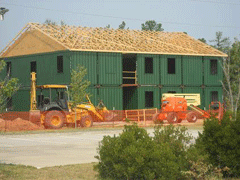
A hurricane-proof house under construction. (Courtesy of SG Blocks)
That also led to interest from around the country, but Siegal hit some resistance talking to local officials.
SIEGAL: Most building departments around the country are not ready to accept the shipping container as a form or as a building element as of yet
LOBET: Still she believes containers hold promise, as long as people use them creatively, cutting windows, stacking them, putting on different finishes.
SIEGAL: Then yes, I think there is an incredible demand for low to moderate income housing, office space – all kinds of ways in which the containers can be sewn into the fabric of the city.
LOBET: Or wherever building speed, wind resistance, and the desire to reuse are priorities.
For Living On Earth, I'm Ingrid Lobet in Anaheim, CA.
GELLERMAN: And to see photos of homes and buildings made with shipping containers, be sure to visit our website: loe.org
Related links:
- To learn more about SG Blocks, click here
- Bill Hinchliff's company
- Jennifer Siegal's company
- Container City
Small is Beautiful
GELLERMAN: Well, each shipping container provides about 320 square feet of living space. Commentator Bonnie Auslander reckons that’s enough room for her to live in. But not her daughter.
AUSLANDER: My seven-year-old dreams big. I mean three stories big. “Oh, why can’t we live in a house with stairs?” she begs me. And it’s not just stairs: she wants a dining room, a laundry room, a playroom, oh yeah, and a sun porch. What we have is a 900-square-foot ranch. You can put more people in a MiniCooper than you can in our living room.
Actually, my daughter says our car’s a problem too: she wants an SUV, not our beat up old compact.
My husband and I are patient. We explain to her that big houses and big cars are bad for the earth. We describe greenhouse gases and tell her how all of us are responsible for the fate of the planet.
And sometimes the message gets through. When she saw confused flowers blooming back in January, she knew that meant that most of them would not be returning for her spring birthday four months later. “People should stop driving those big cars,” she told us, “They’re selfish! They don’t care if flowers are blooming when it’s my birthday!”
But other times she forgets the importance of protecting the environment, especially when she gets a lift home in a Suburban or a Commander. Then she comes in demanding we buy a bigger car with a built-in DVD-player and seats that go flat when you press the button. But being up high is the main appeal.
And hey, I can relate. The time I rented an SUV because we needed it to move, I loved looking down on all the other drivers. Well, on the few of them who were still driving compacts, that is.
So I give up on the environmental angle with her and try a different approach. I use my arms to block off half our 18 by 20 foot living room and remind her, “When we lived in Bangladesh, when you were a baby, this is how big Nisha, your babysitter’s, entire apartment was. And do you know who lived there with her? Her mother. Two people in that tiny space! So to her our house is huge!”
This was a tough sell. It’s hard to convince a child that the bigger your worldview is, the more you value small.
Most recently when my daughter complains, I just kept quiet and nod. Would getting what she thinks she wants really make her happy, I wonder?
Probably not, say the recent studies on happiness. Turns out we’re remarkably poor judges of what will make us content. We check out what we have and compare it to what the people we know have. If we have what they have, or more, then we’re happy – at least for a little while.
And it’s not just kids who do the comparing thing. That hit home last week when a new neighbor came by. He had just moved into an enormous McMansion up the street, one he had helped design, everything just the way he wanted it. He walked into our ranch and looked out the window to the back where our kids were playing together on the swing set. “Oooh, nice yard,” he said wistfully, “Ours is tiny.”
GELLERMAN: Commentator Bonnie Auslander lives in Bethesda, Maryland, and writes on a 13-inch laptop.
[MUSIC: This Car Up “Life In A Small House” from ‘Smile When You’re Alone’ (Tune Core – 2008)]
GELLERMAN: Coming up – probing two profound questions: is there life on Mars, and charcoal or gas for the grill? Stay tuned to Living on Earth!
ANNOUNCER: Support for the Environmental Health Desk at Living on Earth comes from the Cedar Tree Foundation. Support also comes from the Richard and Rhoda Goldman Fund for coverage of population and the environment. This is Living on Earth on PRI: Public Radio International.
Green Grilling
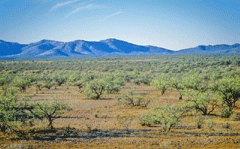
Small mesquite trees like these dot the Sonoran Desert but they are too small to be efficiently harvested for charcoal. (Courtesy of Matthew Taylor)
GELLERMAN: It’s Living on Earth. I’m Bruce Gellerman. Memorial Day’s marks the beginning of summer – time to fire up the grill, kick back and relax. But before you sink too deep into that chaise lounge, consider this profound philosophical question: gas or charcoal? What’s the eco-friendly way to go? Living on Earth’s Bobby Bascomb has the answer, hot off the grill.
[PROPANE SOUND, CLICKING, WOOSH OF FIRE STARTING. BASCOMB ASKS ‘SO WHAT ARE YOU COOKING?’ CHICKEN SIZZLES]
BASCOMB: You might be wondering what to cook on your grill, but Tristram West from the Department of Energy’s Oak Ridge National Laboratory has been working out what to cook with. He’s decided on charcoal.
WEST: Essentially charcoal’s a renewable fuel. It’s derived from wood, so the net emissions are considered zero.
BASCOMB: In life, trees absorb carbon dioxide. In death, they release it, whether they rot in the forest or burn in your barbeque. So, according to West, when charcoal is burned it’s closing a carbon-neutral cycle.
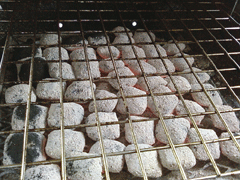
Charcoal briquettes are made from scraps of waste wood pressed together and subjected to a low-oxygen environment. (Courtesy of F Frias)
BASCOMB: But the debate in Southern California, an area notorious for its air pollution, is not about carbon dioxide; it’s about the particulate matter and pollutants that are released by burning charcoal. Sam Attwood of the California South Coast Air Quality District:
ATTWOOD: The propane fuel is just inherently much cleaner than burning with charcoal briquettes.
BASCOMB: So, you’re saying that burning a fossil fuel is cleaner than burning charcoal, which is a wood derivative?
ATTWOOD: Yes, in this case because it is a gaseous fuel that burns with a much more complete combustion than a charcoal briquette, the amount of pollutants will be much, much smaller. When you think about, let’s say, burning a log in your fireplace the pollution is so great that you can actually see visible emissions.
BASCOMB: Attwood’s especially worried about lighter fluid, the flammable liquid impatient people pour on charcoal to get it started. In 1990 Southern California required that makers of lighter fluid cut the air polluting ingredients in their products by half. Sam Attwood says the results were significant.
ATTWOOD: We found that just the starter products alone were responsible for several tons per day of the so-called volatile organic compound emissions. Now that’s equivalent to a pretty large oil refinery.
BASCOMB: So, burning lighter fluid causes air pollution. But the Department of Energy says the actual grilling isn’t a big deal. It estimates that on the fourth of July, the busiest grilling day of the year, barbeques will only generate about one percent of the total carbon dioxide emissions in the U.S. And the DOE’s Tristram West still sides with charcoal as a renewable resource.
WEST: About 90 percent of all the wood used for charcoal is all essentially wood waste from lumber yards. So it’s not as though we’re going in and cutting down trees so we can grill hamburgers.
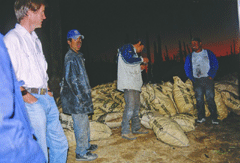
University of Denver geography professor Matthew Taylor (left) with charcoal harvesters in the Sonoran Desert. (Courtesy of Matthew Taylor)
TAYLOR: I call the North American demand for charcoal a demand for a chic grilling fuel.
BASCOMB: That’s Matthew Taylor, professor of geography at the University of Denver. His research in the Sonoran desert suggests that demand for mesquite charcoal is leading to deforestation. But paradoxically there’s no shortage of mesquite saplings.
TAYLOR: If anybody has driven through southern Arizona, Northern Mexico, you will notice a mesquite infestation, and that’s a consequence of running cattle in the area. The cattle eat mesquite pods during dry times, and then they wander off and the mesquite seeds are passed through their system and you have a wonderful sprouting of new mesquite all over.

Small mesquite trees like these dot the Sonoran Desert but they are too small to be efficiently harvested for charcoal. (Courtesy of Matthew Taylor)
TAYLOR: So you get this little, tiny, multi-stemmed mesquite that looks very scrubby and shrubbyish. That’s not good for charcoal. You’d have to go and cut down hundreds of those where as you’d have to cut down one old-growth mesquite, and some of those are several hundred years old. There’s definitely deforestation associated with that.
BASCOMB: So, what’s a green griller to do? It’s a simple question but there’s no easy answer. Propane burns cleanly, but is non-renewable. Charcoal briquettes are renewable, but may pollute. Hardwood charcoal could cause deforestation, but it tastes great.
Confused, I’m Bobby Bascomb for Living on Earth
[FOOD SIZZLING ON GRILL; I THINK IT’S DONE; CLOSE LID]
Related links:
- Matthew Taylor’s Homepage
- Department of Energy Oak Ridge National Laboratory
- South Coast Air Quality Management District
[MUSIC: Marcia Ball “Peace Love and BBQ” from ‘Peace Love And BBQ’ (Alligator Records – 2008)]
Searching for Life on the Red Planet
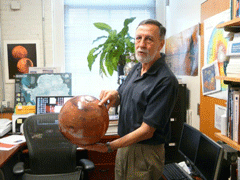
Samuel Kounaves holds a globe of the Red Planet. (Photo: Bruce Gellerman)
[MAN COUNTS DOWN 'T MINUS TEN, NINE, EIGHT…']
GELLERMAN: AUGUST 4, 2007, Cape Canaveral Florida.
[SIX, FIVE…]
GELLERMAN: NASA’S Phoenix Mission to Mars is poised to begin.
[MAIN ENGINES START, TWO, ONE, ZERO AND LIFTOFF OF THE DELTA II ROCKET WITH PHEONIX, A DISTANT SCIENCE OUTPOST SEEKING CLUES OF THE EVOLUTION AT THE POLAR REGION OF MARS]
GELLERMAN: Four hundred twenty one million miles and ten months later, the Phoenix Mars Lander is scheduled to set down near the North Pole of the red planet this week.
We’ve been sending missions to Mars’ surface for more than 30 years. Mars, on the other hand, has been visiting us for time immemorable. Not tiny green men, but rocks. You can find one in Sam Kounaves’s office at Tufts University. Professor Kounaves keeps it in a small glass bottle labeled ‘Shergottite.’
KOUNAVES: We do have a little nugget from Mars actually.
GELLERMAN: Let me just see.
KOUNAVES: Well, it’s a piece of Mars.
GELLERMAN: Martian meteorite –
KOUNAVES: Sample

Mars Mission Co-Investigator Samuel Kounaves looks at a sample of a Martian meteorite found in Antarctica. (Photo: Bruce Gellerman)
KOUNAVES: So, many years ago, it was discovered that some of the meteorites that had been picked up in Antarctica were actually from a planet. It was a terrestrial planet, and there’s a crust on the outside here – that’s the fusion crust – so you know a meteorite because it comes through the atmosphere, and it burns the outside of the meteorite. So they found in this meteorite little glass bubbles that have sealed who knows how long ago, and in those glass bubbles was gas, and the gas matched Mars’ atmosphere exactly.
GELLERMAN: Can I touch it?
KOUNAVES: Well, no we try not to touch it. (laughs)
GELLERMAN: I can’t touch it. Whoa, but this is about as close to Mars as I’m gonna get.
[FOOTSTEPS]
GELLERMAN: Actually, Mars was a lot closer than I thought. You can find it in a lab just down the hall from Kounaves’s office.
[DOOR CREAKS OPEN; KOUNAVES SAYS ‘THREE OF MY PEOPLE WHO WORK HERE ARE NOT HERE…’]
KOUNAVES: This is our Mars Chamber. This is – we use this to test some of the instruments and also do experiments on Mars soil at Mars conditions. So inside here we generate the atmosphere of Mars at the pressure of Mars and also the temperature that it is on Mars. So what we have is a mini-Mars here.
GELLERMAN: It looks like an autoclave. It’s got a lot of, you know, valves.
KOUNAVES: Yeah. Let me see if it’s still on here, if I could turn this –
[MARS CHAMBER SWITCHED ON; MOTOR STARTS UP]
KOUNAVES: So right now what it’s doing is it’s making it like Mars in there. We won’t go all the way, it takes about half an hour to get everything just right.
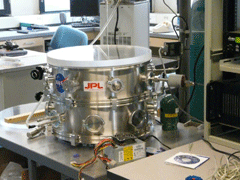
The Mars Chamber can simulate atmospheric conditions found on Mars. (Photo: Bruce Gellerman)
GELLERMAN: Why Mars? Why do you think of going to Mars?
KOUNAVES: Well actually Mars is one of the best places in the solar system that we could probably settle some day. I mean there’s not many planets in the solar system that are Earth-like. We want to know is the soil like Earth soil, for example? Did it ever have life, did it support life, could it support life? Could you plant things there and have them grow?
GELLERMAN: For answers to these questions, Kounaves hopes to dig deep. Previous Mars landers have only scratched the surface of the red planet. But the Phoenix Mission Lander is equipped with a robotic arm that can drill into the frozen polar soil.
KOUNAVES: Some of us think that if there is life on Mars, it’s probably very, very – it could be very deep. I mean we found life on Earth only recently very deep. And so we’ve been living here for a long time, and 20 years ago we didn’t believe there was life on Earth subterranean, and now it’s been pretty well established by several groups that there are bacteria happily thriving underneath us thousands of feet below. These organisms basically eat the sulfur in the rock and thrive. Those creatures would be happy on Mars in the subterranean area.
GELLERMAN: Mm hmm. Hence you’re gonna dig under the surface.
KOUNAVES: Hence we’re gonna dig.
GELLERMAN: So you scoop down about a meter – half a meter.
KOUNAVES: We start at the top, slowly digging down, and see how far we go. We take samples along the way, and then hopefully we will find ice at some point.

Samuel Kounaves holds a globe of the Red Planet.
(Photo: Bruce Gellerman)
KOUNAVES: Absolutely, yeah, it's frozen. I mean we have no doubt there’s water on Mars. The question is when was it liquid and is it liquid any time now?
GELLERMAN: To find out, Kounaves’ lab developed a unique miniaturized experiment – a test in a teacup. It looks a little like a mini black monolith from “2001: A Space Odyssey.”
KOUNAVES: All the sensors are mounted on the inside of the wall of the little cup, this black little box.
GELLERMAN: So the sample gets deposited in there?
KOUNAVES: The sample gets dumped onto the screen there, the little drawer is open at that point, and then the drawer loses and dumps the sample in there.
GELLERMAN: This is a little chemistry laboratory?
KOUNAVES: It is. It’s basically a small little chemistry laboratory. It’s very simple science, I mean when I talk to elementary school kids, they understand what we’re doing. We’re measuring the acidity – how acid the soil is – we’re tasting the soil. How salty is the soil? And we want to know what nutrients are in there. We’re asking basically, you know, is this soil friendly?
If an astronaut goes there some day, are they gonna find dust that, once it touches water or their skin, basically turns into something like sulfuric acid or Clorox bleach? Or is it like the soil out in your back yard that’s friendly, pH-7 and you can grow plants in?
GELLERMAN: What was the biggest challenge that you faced?
KOUNAVES: Our biggest challenge has been to make sure that the instruments operate under the conditions we’ll find on Mars, to make sure they operate once or twice very reliably. I mean, so what you see here – unlike here on Earth where you buy things and you want them to last a long time, this doesn’t have to last long, but it has to work the first time well. And so it has to work after being vibrated, frozen down to minus 60, 70 degrees. And NASA does horrible things to this stuff. And so in the process of building this, it had to go on a lot of tests, and then it’s tested and tested and tested at extreme conditions – and that’s hard.
[AUDIO FROM “SEVEN MINUTES OF TERROR”]
KOUNAVES: It’s got thrusters that turn on in the last 30 seconds, and it’s very scary. The last seven minutes of this mission are the scariest, there’s a – if you go on our website there’s a little clip NASA has put out there. It’s called “Seven Minutes of Terror.”
[“SEVEN MINUTES OF TERROR”]
This is at the last seven minutes, it basically hits the atmosphere, it has to slow down from 12,000 miles an hour down to about five miles per hour, before it hits. You know, it has to open up the parachute during that time, it has to let itself go and then fire the rockets the last 30 seconds, and then come down on all three legs somewhere nice and easily – on its own.
[“SEVEN MINUTES OF TERROR”]
And seven minutes later, eight minutes later, it radios back to Earth: ‘I’m here.’
[“SEVEN MINUTES OF TERROR”]
KOUNAVES: We’re looking for microbial life. We don’t expect to find little things scurrying around Mars or anywhere in the solar system. What we’re hoping to find, like in the dry valleys, is simple, microbial life that has evolved and survived for billions of years.
GELLERMAN: Could you imagine – I guess you have imagined – what happens if we actually find that?
KOUNAVES: Yea, it’s an interesting question, I mean, it’s a philosophical question. For a lot of scientists, I think we’re pretty convinced that there’s life out in the universe. Personally my belief is that life is an emergent property in the universe, and that there’s probably a lot of places where life has emerged, and in some places it has evolved maybe very little, and in other places it has evolved to areas – maybe stages where, similar to ours.
GELLERMAN: So I’ve gotta ask you professor – would you go?
KOUNAVES: Would I go?
GELLERMAN: Yeah.
KOUNAVES: (laughs) Well you know, it’s funny. I have a sixth grade notebook, and I wrote in it – it was like what you want to do stuff – and I wrote I wanted to be an astronaut and go to Mars. But I would go if it was – you know, yeah – but it would be interesting to go there and actually be able to do science on the surface. But I don’t think my wife and kids would appreciate my going necessarily right now. (laughs)
[MUSIC: Marty Quinn, “Mars” music available at www.drsrl.com]
GELLERMAN: Tufts university extreme chemist Sam Kounaves, whose experiments are aboard the Phoenix Mars Mission Lander.
Related link:
To learn more about exploring Mars, click here
GELLERMAN: You can hear our program anytime on our website or get a download for your mp3 player. The address is loe.org. That’s l-o-e dot o-r-g. You can reach us at comments@loe.org. Once again comments@loe.org. Our postal address is 20 Holland Street, Somerville, Massachusetts 02144. And you can call our listener line at 800-218-9988. That’s 800-218-9988.
Mars Music
GELLERMAN: Well scientists aren’t the only ones fascinated with the red planet. Musicians, from Holtz to Ziggy Stardust, have made music to honor the planet.
Marty Quinn, a drummer and computer scientist, was inspired by the 2001 Mars Odyssey Orbiter Mission, and used data collected from its gamma ray spectrometer and neutron data collector to create this piece, simply called “Mars.”
[MUSIC: Marty Quinn, “Mars” music available at www.drsrl.com]
QUINN: The gamma ray spectrometer on the Mars Odyssey spacecraft – it had a big boom off the spacecraft, and it was looking down at the planet. And those gamma rays are caused by cosmic rays hitting the planet’s surface, bouncing around within the planet and then some of them bounce out again. And because of what they hit in the planet’s surface, the scientists can tell ‘Oh, hey, there’s water there.’
So, the gamma ray spectrometer became – in particular became the melody, and then the neutron data collector was collecting three kinds of neutrons that emanate from the surface also, that give the scientists other information, and us, about the carbon dioxide ice that is on the surface at different seasons.
Those were represented by three patterns of music: one was a slow bass pluck; one was a beautiful string pattern in the middle of a keyboard; and then at the high register we had a very fast piano. And the data controlled the volume of those patterns.
So its just like a person, you know, everybody has a certain sound to them as they walk or as they speak, so it’s a very natural metaphor that I used in this case.
The phoenix is landing at an area on Mars that is representative of my favorite music on Mars, which is the northern polar area, and I’m not surprised, because it represents a place on Mars where there’s a lot of variation from winter into summer, where the ice is quite prominent during the winter, but then it quickly melts and exposes the ground and therefore exposes the water underneath. I’m a drummer at heart, and I’m a musician and composer at heart, so I want the data to be expressive just like music is expressive.
GELLERMAN: Musician Marty Quinn composed this tune using data from the 2001 Mars Odyssey Mission, supplied by John Keller from the lunar and planetary lab at the University of Arizona.
Our stories about Mars were produced with the help of Annie Jia and Jeff Turton.
Related links:
- Marty Quinn
- Click here to hear a longer version of Mars music
[MUSIC: Eco-Elvis, “Earth Day Rock”]
On the next Living on Earth. Eco-Elvis has entered the building.
[MUSIC: Eco-Elvis, “Earth Day Rock”]
ECO-ELVIS: If the flashy costume doesn’t get ’em, the music will, and if the music doesn’t get ’em, the message and the words will get ’em. So it’s kind of like a, you know, four, five tier punch. If I can’t get ’em one way, I’ll get ’em another.
[MUSIC: Eco-Elvis, “Earth Day Rock”]
GELLERMAN: Eco-Elvis – thank you very much! On the next Living on Earth.
GELLERMAN: We leave you this week in the middle of a lek.
[EARTHEAR: Lang Elliott “Chicken Lek.” Sound provided by Mr. Elliott for Living On Earth]
GELLERMAN: Leks are breeding grounds where certain species like these male Greater Prairie Chickens, perform display rituals and compete for the affections of females.
Nature recordist Lang Elliott got up at the crack of dawn, and set up his equipment at the Prairie Chicken lek in the Nebraska National Forest to record the males struttin’ their stuff.
Living on Earth is produced by the World Media Foundation. Our crew includes Ashley Ahearn, Bobby Bascomb, Eileen Bolinsky, Ingrid Lobet, Helen Palmer, Mitra Taj and Jeff Young, with help from Jennifer Baessler, and Sarah Calkins.
Our interns are Annie Jia and Margaret Rossano. Jeff Turton is our technical director. Alison Lirish Dean composed our themes. You can find us at loe dot org. Steve Curwood is our executive producer. I'm Bruce Gellerman. Thanks for listening.
ANNOUNCER: Funding for Living on Earth comes from the National Science Foundation, supporting coverage of emerging science, and Stonyfield Farm: organic yogurt and smoothies. Stonyfield pays its farmers not to use artificial growth hormones on their cows. Details at stonyfield.com. Support also comes from you our listeners, the Ford Foundation, the Town Creek Foundation, the Oak Foundation supporting coverage of climate change and marine issues and Pax World Mutual Funds: socially and environmentally sustainable investing. Pax World: for tomorrow. On the web at paxworld.com.
ANNOUNCER 2: PRI: Public Radio International.
Living on Earth wants to hear from you!
Living on Earth
62 Calef Highway, Suite 212
Lee, NH 03861
Telephone: 617-287-4121
E-mail: comments@loe.org
Newsletter [Click here]
Donate to Living on Earth!
Living on Earth is an independent media program and relies entirely on contributions from listeners and institutions supporting public service. Please donate now to preserve an independent environmental voice.
NewsletterLiving on Earth offers a weekly delivery of the show's rundown to your mailbox. Sign up for our newsletter today!
 Sailors For The Sea: Be the change you want to sea.
Sailors For The Sea: Be the change you want to sea.
 The Grantham Foundation for the Protection of the Environment: Committed to protecting and improving the health of the global environment.
The Grantham Foundation for the Protection of the Environment: Committed to protecting and improving the health of the global environment.
 Contribute to Living on Earth and receive, as our gift to you, an archival print of one of Mark Seth Lender's extraordinary wildlife photographs. Follow the link to see Mark's current collection of photographs.
Contribute to Living on Earth and receive, as our gift to you, an archival print of one of Mark Seth Lender's extraordinary wildlife photographs. Follow the link to see Mark's current collection of photographs.
 Buy a signed copy of Mark Seth Lender's book Smeagull the Seagull & support Living on Earth
Buy a signed copy of Mark Seth Lender's book Smeagull the Seagull & support Living on Earth

